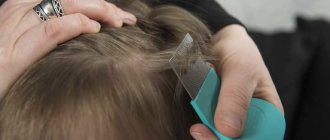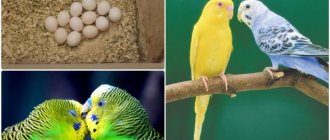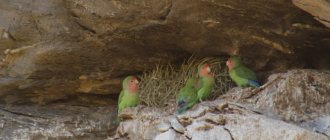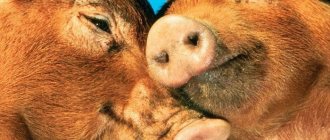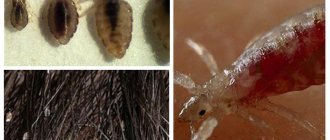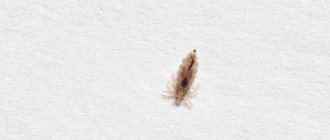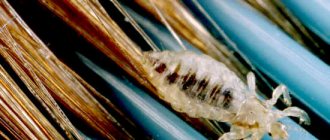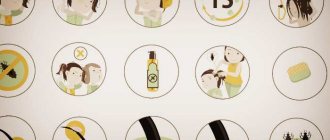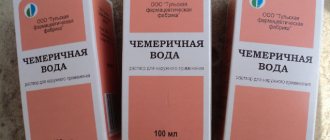No one is immune from the appearance of head lice. They don't care about your age, gender or social status. If conditions are favorable, lice will actively reproduce and you will have to make some efforts to get rid of them. Moreover, lice can get to you in different ways. Infection of people with head lice occurs directly through contact with a person infected with lice. This mainly occurs when hair touches. Infection can also occur indirectly through the use of items used by a person with lice, including combs, hats, bedding, and so on.
Development of pediculosis
After reaching a new host, the adult leads an active life, feeding and reproducing. Every 4 hours, this blood-sucking parasite drinks its portion of blood. The nymph even feeds every 2 hours. A little blood is consumed and the bite itself does not cause pain. But due to the substance contained in saliva, irritation appears on the skin, causing itching.
As the number of bites increases, the irritation becomes stronger, and accordingly, the symptoms of lice become more pronounced. When pediculosis develops, its signs include:
- presence of severe itching;
- the appearance of poorly healing scratches on the scalp due to a large number of bites;
- an infection can get into the wound, which makes the skin damage more significant;
- with an active process, it is possible for hair to stick together with serous-purulent exudate and the appearance of a so-called “tangle”;
- Due to constant itching, a person becomes more irritable.
At first, after the appearance of parasites, you may not notice their presence. Not everyone attaches importance to minor skin irritation from a few bites. But as their number increases, the development of pediculosis will be difficult to miss. Considering how quickly lice lay eggs and how quickly they grow into adults, it will take no more than 2-3 weeks before the parasites are detected even on an unsuspecting person.
Lice can cause serious harm to a person's health if they become infected. In this article you can find out more about why they are dangerous.
What determines the length of the incubation period for pediculosis?
Summarizing, we can sum up how long it may take for a person infected with lice to fully feel the presence of parasites on his body and sound the alarm. Its duration is affected by the type of lice, their initial number that got to the victim, as well as the circumstances that provoked the infection. It is the last point that has not yet been disclosed, although the protective measures that can be taken to avoid such a nuisance as encountering lice directly depend on it.
Most often, such situations lead to the discovery of blood-sucking insects.
- Long-term isolated accumulation of people - work collectives, organized recreation (boarding houses, tourist centers, camps, sanatoriums, hotels, collective hikes), places of deprivation of liberty, dormitories, boarding schools, barracks, camps for refugees or victims of disasters.
- Organization of studies and leisure (school, kindergartens, nurseries, clubs, sports sections, fitness, gym, swimming pool).
- Traveling on a train, especially with an overnight stay, or on a plane or bus over a long distance.
- Visiting hairdressing salons, public steam rooms and saunas.
- Renting temporary housing, be it a hotel or a rented apartment.
It is no less dangerous to try on or borrow other people's things - linen, towels, clothes, hats and headwear.
Stages of the lice life cycle
The life cycle of lice involves passing through three stages of development:
- Nit.
- Nymph.
- Adult.
If we talk about reproduction, this period usually takes no more than 10 days for lice. During this time, mating, fertilization, laying and maturation of eggs occurs. Each female lays more than 150 eggs during her life, which lasts on average from 30 to 45 days. Therefore, it is not enough to simply detect lice eggs on the hair and remove them; it is important to get rid of all nits, nymphs and adults. Otherwise, even one fertilized female can lead to the appearance of a large population of parasites on your head.
Nits phase
Fertilization of female lice occurs once, during which all of her eggs are inseminated. And the first egg laying can be done within a few hours after insemination. That is, sometimes it’s not about how many days it takes for lice to lay eggs, but about how many hours after they do this. Positioned on the hair near its root, the female first releases sticky mucus and then an egg. Mucus is a viscous substance that quickly hardens in air, which provides the egg with good protection and reliable fixation.
This formation is called a nit. And inside such a peculiar cocoon, the larva develops quite quickly. Under favorable conditions, it can take from 5 to 10 days from the moment the egg is laid until the larva emerges. The larva gets out by gnawing the wall of the cocoon, and it comes out very hungry, starting to feed heavily.
Larval transformation
In its appearance and feeding method, the larva is similar to adult parasites. But her body is growing quickly and the protective chitinous shell cannot keep up with these changes. Therefore, 3-5 days after leaving the cocoon, this hard shell is shed. The body of a naked nymph hardens in the air, and she regains her previous appearance, having increased in size.
After this transformation, the 2nd stage of larval development begins, which also lasts about 3-5 days. After this, a second molt occurs. After repeated molting, the nymph develops the genital organs, which occurs over the same 3-5 days. Then the last transformation occurs, when the larva already becomes an adult sexually mature individual (imago). Now she is ready to mate. Considering how many eggs a lice lays, in just a month of inactivity you can get a whole horde of parasites.
The transformation from larva to adult usually occurs in 13-16 days. But if the temperature conditions worsen, these periods can be doubled.
Nymph
The nymph is similar in appearance to the adult, but differs in its smaller size and the fact that it cannot reproduce. Since lice grow in size at this stage of the life cycle, they need increased nutrition. Therefore, nymphs feed approximately twice as often as adult parasites. In this regard, we can say that they are the ones who cause the greatest discomfort to a person.
Adult
Adults reach 4 mm in length, are endowed with a chitinous translucent elongated body and three pairs of legs. The body has a light brown tint, but when saturated with blood it becomes dark. Lice easily bite through the skin to suck blood. At the same time, they inject saliva into the bite site, which prevents the blood from clotting. But this causes irritation on the skin, causing itching.
After the nymph turns into an adult, 1-2 days pass, during which it finds a partner, mates and begins to reproduce. And the very next day after fertilization, and sometimes a few hours later, the female lays 2-4 eggs per day. Lice have no enemies; they only need to undergo fertilization once in order to be able to reproduce for the rest of their lives. Also, the power source is always available. These are almost ideal conditions, which is why the parasite population is growing rapidly. Moreover, after mating, males do not live for 30-45 days, like females. It usually takes about 7 days after insemination before they die.
Frequently asked questions from our readers
Expert opinion
Alexandra Valerievna
Doctor-Trichologist
If nits click, does that mean they are alive?
Living nits, when pressed with your fingers or nails, make a characteristic click, as if a soap bubble is bursting. The sound of this click is quite loud and strong. If the nit is dead, then it will not make any sound, no matter how hard you press and squeeze it. If it makes any sound, it means that it is still alive and it is necessary to take repeated measures to remove them.
How not to confuse nits with regular dandruff?
The most popular method is visual analysis of the “crumbs” that you have discovered. The skin scale, unlike the nit shell, is less dense to the touch and it does not separate, while the egg is dense and clicks when you press it. Nits are also distinguished by their excessive yellowness from ordinary dandruff.
Is there a risk of getting lice and nits again?
There is, of course, such a risk, since even if you try to maintain a certain good level of hygiene, do not use shared objects and do not swim in public places, a carrier person with whom you have had close contact and whose lice really liked you.
Basic ways to combat head lice
Among the people, before the advent of modern medicine, the prevention of pediculosis was carried out by shaving the hair to zero; in our time, cutting one's head is also sometimes practiced, but thanks to modern medicine, the main ways to combat pediculosis are:
Pharmacy products
Of all the pharmaceutical drugs, the most suitable, effective and safe means are Medifox and Paranit. These two drugs do not contain harmful chemicals; they gently remove parasites from their location, without side effects. Also, these two drugs are perfect for children, since they have minimal toxicity and, consider, almost no side effects. Also, tablets are used to get rid of head lice. After the human carrier begins to take the pills, the lice, having sucked on the blood, die.
Shampoos
Shampoo can also be used as a means to combat lice and nits, but most often it is used after the destruction of parasites, as a preventive measure and to remove the shells of dead pests from the wearer’s head. A good example would be Pedilin. This shampoo can be used by both children and adults without worrying that it will harm them in any way. A course of treatment for head lice with shampoo lasts at least three days to completely eliminate the likelihood of recurrence of the disease. When washing your hair, you need to place a disposable towel or napkin on your shoulders and then dispose of them.
Sprays
Another effective remedy against lice and nits can be a spray, for example, Nyuda or Para Plus. These sprays are suitable for both adults and children, as they do not contain toxic substances that could harm health or cause side effects on the body.
Scallop
The comb is more suitable for removing already killed parasites from the hair of a human carrier, but it is also sometimes used to remove still living individuals from the scalp. Most often, the comb is sold complete with a preparation against lice and nits. Initially, an anti-parasitic agent is applied, which will kill all lice and nits, or at least most of them, and then they are removed from the hair with a comb. If you do not remove the dry shells remaining from nits and lice from your hair, a burning sensation on the scalp may occur and scabies (itching) may begin, since the shells of the parasites are somewhat toxic and release their poison.
Folk remedies
You can get rid of parasites using folk remedies, but this will not be as effective as medical means, and lice and nits will not be removed from the human carrier in one procedure. There are a variety of folk remedies for lice and nits. Some people shave their heads when parasites appear, others prefer to use kerosene, tar and laundry soap, vinegar or lemon juice and much more, using home remedies and treatment methods, it is worth remembering that some of them can cause an allergic reaction or a chemical burn (kerosene , vinegar, dichlorvos).
REFERENCE! It is worth giving preference to medical products that will be more effective in treating head lice.
Favorable conditions for the development of lice
Temperature and humidity are of greatest importance for the development of pediculosis. The optimal temperature for the development of lice is about +30 degrees Celsius, then the larva emerges from the nit in the shortest possible time, and the nymph grows to an adult as quickly as possible.
If the air temperature drops to +10 degrees, this leads to a slowdown in development for several days. At an air temperature of -10 degrees, adults and nymphs die in 1-2 hours. For nits to die, an air temperature of no higher than -20 degrees is required, since they are attached to the roots of the hair and they have natural “heating” from the human body.
Elevated temperatures also lead to the death of lice. For adults, the lethal temperature is +50 degrees, for nits +60 degrees. Even if the temperature has reached +40 degrees, under such conditions the adults stop feeding and reproducing.
Timing depending on the type of parasite
If the adult head has just been discovered, it must be found in the hair and destroyed. Hair can be treated with a special shampoo, which is sold at the pharmacy kiosk.
The time frame for getting rid of parasites and the stages of therapy depend on the degree of damage. Sometimes you have to carry out several sanitary treatments and hair combing before getting rid of this unpleasant problem forever.
To combat pubic and body lice more effectively, you need to shave the hair not only on your private parts, legs, but also on your eyebrows. To remove hair right down to the root, you need to additionally use hair removal creams. For preventive purposes, use special sprays.
What do lice eggs look like on your head?
To fight these parasites, you need to know what lice eggs look like on your hair. In appearance, they can resemble dandruff, being small in size and whitish, grayish or beige in color. But there is a simple tip on how to distinguish dandruff from lice eggs. Nits are firmly attached to the hair at a short distance from the scalp. Dandruff is located directly on the skin and is easily shaken off from the hair if it gets on it.
Typically, these parasites lay several eggs on adjacent hairs, so the nits are often located in “clusters.” The female will often choose the warmest areas of the head to place her eggs, including the base of the neck, the area behind the ears, or the side of the head on which the person sleeps.
Symptoms and causes
There are several varieties of lice depending on where they live: head lice, body lice, and pubic lice.
Head lice are thought to be most common in children. For this reason, in educational institutions students are constantly checked for the presence of nits.
Girls are more likely to get parasites than boys, possibly due to long hair. However, the last 10 years of research in this area have proven the opposite situation.
Nits (lice larvae) easily attach to human hair, and this has nothing to do with hygiene.
Video:
Even the cleanest and most well-groomed people can become infected with parasites due to contact with an already sick person.
According to statistics, in Russia, lice are found in 300–700 people for every hundred thousand people, and only 15% of them are children.
These parasites cannot live without food for a long time, so they constantly need human blood. A hungry parasite is gray-brown in color, while full lice are black or red.
Lice larvae are called nits. They are oval in shape, pale yellow in color and about 1 mm long. After about 5 to 8 days, lice emerge from the nits.
Parasites live on a person’s head and constantly need food, since they cannot live without blood even for one day. You can see what lice look like in the photo below.
For the first two weeks after lice appear on the head, the owner may not be aware of their existence.
After which itching of the skin and irritation from parasite bites appear. At first, the symptom manifests itself in a milder form, after which the itching intensifies and can become unbearable for the person.
If the disease becomes chronic, the patient scratches his head out of habit, even if he does not actually experience itching.
As a result, acute dermatitis develops, small red papules appear, and skin damage from scratching is possible.
After some time, a person may develop anemia, a secondary infection, strands will begin to stick together, and there may even be a smell of rot (in an advanced form of the disease).
The causes of lice are usually associated with close contact with a carrier of the disease, since the parasites themselves cannot fly or jump long distances.
This explains the frequent appearance of lice in children, who often change clothes, hats, and use other people's combs or towels.
In addition, they are the ones who come into contact with a large number of people more often than adults (at school, kindergarten, health camps, in the yard).
It is very difficult to explain to a small child that you cannot try on other people’s hats, especially when the child is far from his parents.
Adults can become infected with head lice in trains, swimming pools, medical facilities, public baths or hair salons.
Video:
To avoid infection and the need for long-term treatment, you can treat certain areas around the scalp (neck, forehead, behind the ears) with lavender or tea tree essential oils.
Also, carefully monitor your things, wash them more often, iron every seam, do not use other people’s combs and do not give yours to anyone, and under no circumstances try on other people’s hats.
When parasites appear, it is necessary to disinfect items of clothing, linen, hats, toys, towels (all things on which lice or nits could remain).
During this time, living parasites will die, as well as those that hatch from nits, since without human blood these parasites will not be able to survive.
If you need to determine the presence of the disease at home, you can comb your hair by tilting your head over a light towel.
If larvae or live parasites are found, it would be advisable to consult a doctor who will prescribe treatment.
Read about how long the incubation period of parasites lasts in the next section.
Preventing Infection
To prevent infection, you need to remember where lice come from. Awareness of modes of transmission will help maintain vigilance. Attentiveness to symptoms is useful for timely detection of the disease.
Those who are predisposed and at risk should be concerned. Any unexpected contact with a stranger is a sign of suspicion. Especially if the individual’s appearance does not inspire confidence. Excessively close human relationships with strangers are dangerous.
Regular presence in a crowded mass of people (public transport, public events, sports competitions) is a reason for control and prevention. Parents should check their children more often. The greatest attention is paid to offspring leading an active lifestyle.
In addition to the contact method of infection, there is a subject method. Lice are spread through the use of other people's things. This applies to household items, hygiene products, clothing, jewelry (bed linen, towels, hairpins, combs). You should stop borrowing foreign things and teach your children this.
If you visit public baths, swimming pools, or swim in open tanks with stagnant water, it is recommended to monitor the condition of your skin and hair. A wet environment keeps lice viable without food for up to 2 days, and pubic lice for longer.
In all of the above situations, it is recommended to closely monitor the possible appearance of parasites . Previously unusual manifestations should alert you to:
Any suspicion is a reason to consult a doctor and carry out preventive treatment. This is especially true for cases of contact with known sick people.
Myths are not born out of nowhere. There is an opinion that lice appear due to stress. Overexcitation itself does not relate to the appearance of insects. But a nervous state with increased sweating and improved blood flow is an excellent bait for parasites. Read more about whether lice can appear due to nervousness on our website.
Information about the incubation period of lice and nits is useful to many. Periodic encounters with the causes of head lice are inevitable. Recognizing symptoms in time, knowing how long it takes for them to become possible, and starting treatment in a timely manner is important for effectively getting rid of parasites.
How long do nits live?
After the female louse has laid larvae on human hair, the eggs must go through 3 phases of development. A nit is a cocoon containing a future louse. During maturation, it does not need nutrition, so if for some reason it leaves the host’s body, it will be able to maintain its vital functions for about 8 days before hatching from the egg. If a small louse cannot immediately find food, it dies within 24 hours
For the maturation of nits, the most important is the temperature regime. If the nit is in hot conditions, the louse may hatch after 4-5 days. This is possible when wearing hats in winter, since a kind of greenhouse conditions are created under it. Therefore, after combing your hair, you need to thoroughly disinfect the entire room.
How long do lice live on clothes and linen?
The development cycle of the parasite from the larva to a healthy individual lasts 20 days, and the life expectancy of an adult insect is from 27 to 46 days. Without food, they can maintain their viability for a much shorter period:
- The death of a human louse occurs on the second day. When the temperature drops, the fasting period can increase to 10 days.
- The fish can maintain vital functions outside the host’s body for about 8-9 hours, and in water for no more than 2 days.
How long does it take for a child to get rid of lice?
The treatment process can be either one-time or last for a couple of months . It all depends on the degree of parasite population. If a child brings lice from a child care facility, all children need treatment, otherwise re-infection will occur.
Girls with long hair will have to endure for some time while the fight against the parasite is carried out . No drug can deal with thick hair alone. Re-processing required. Boys can have their heads cut.
Can a head louse survive outside of humans?
There is only one answer to the question of where lice (head lice) live: humans are the only creature on which these parasites can live. Sometimes they settle on some species of monkeys, but they feel uncomfortable there.
How long do lice live outside the head? Situations may occur when, for some reason, the parasite is separated from its “carrier” (it is combed out, remains on personal hygiene items, etc.). Thus, if the louse does not have the opportunity to return to the human head as soon as possible, it will be left without food. This is enough to last another 1-3 days, and that’s all how long lice live outside a person, after which they die of starvation.
Interesting! Lice spend their entire life cycle - from egg to death - on humans, and as long as a louse lives, it feeds on human blood. Without food, the parasite will not last long.
Regarding the survival of parasites outside their usual environment or where lice live other than the head, there are a number of frequently asked questions:
- Is it possible for lice to live without a person, for example, on another animal? The head louse is not capable of living anywhere in nature except on the human head (except for rare cases with monkeys, which have already been mentioned). Therefore, it is impossible to infect your pets with these bloodsuckers or become infected from them yourself.
- How long do lice live on clothes? It happens that a combed louse ends up outside the head, for example, on clothing, where its lifespan will also average 2 days. But to a greater extent, this question applies to body lice, which live on clothes (in seams and folds), “visiting” the human body for food.
- Can lice live in pillows? To live is not, but to exist for a few hours is quite possible. Lice can end up on a pillow if they crawl onto it from the head of an infected person. Having remained there, the parasites will hold out for some time, waiting for the person’s head to fall back onto the pillow, after which they will return “to their homeland.” Therefore, to the question of whether lice live in bed linen in general and on pillows in particular, there is only one answer: even body bloodsuckers, not to mention head lice, are incapable of this, due to the periodic long absence of a person in bed.
- Do lice live on colored hair? Modern hair dyes often contain hydrogen peroxide, which is already toxic to lice. Many individuals may die, however, a sufficient number of individuals (especially nits) will remain alive, so hair coloring cannot be called widespread bullying. The surviving parasites will continue to actively reproduce, and the pointlessness of destroying them in this way will be obvious.
